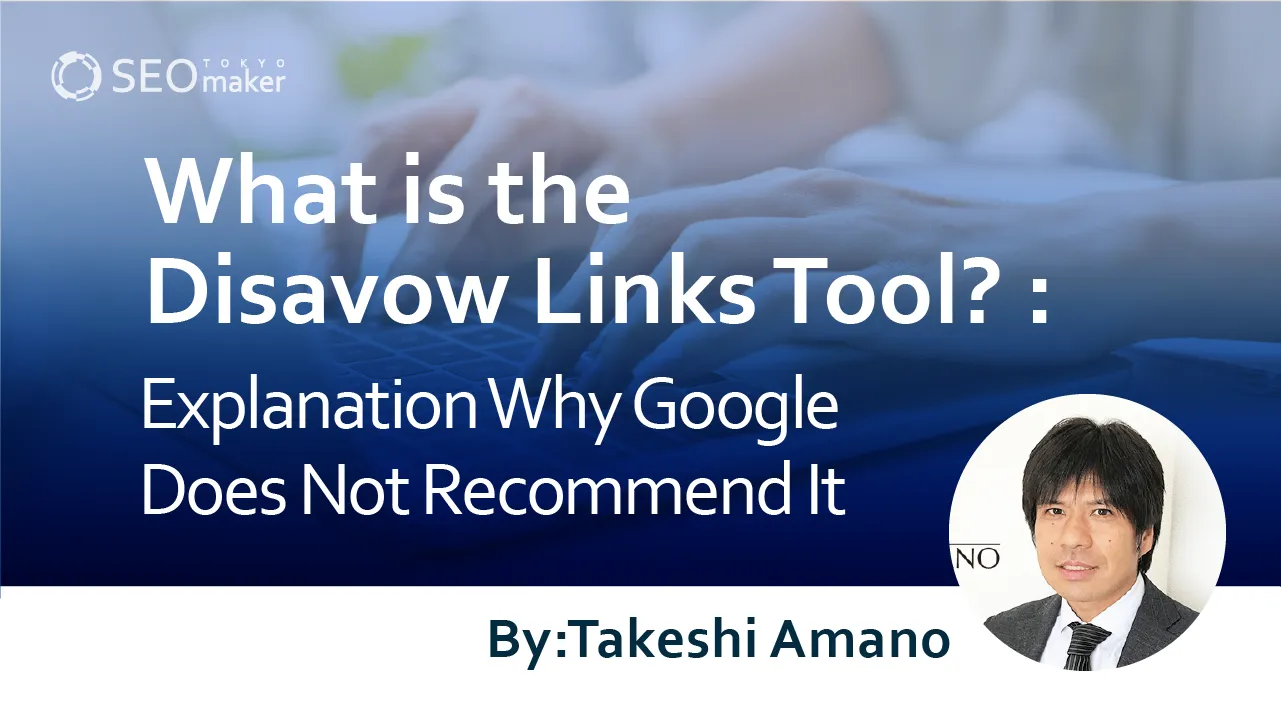What is the Disavow Links Tool? : Explanation Why Google Does Not Recommend It
contents
- 1 What is the Disavow Links Tool?
- 1.1 [Note] Google Does Not Recommend Using the Disavow Links Tool
- 1.2 Why Google Does Not Recommend Using the Disavow Links Tool
- 1.3 Low-Quality Links Are Not Valued
- 1.4 Implementation of the Penguin Update
- 1.5 Implementation of the Panda Update
- 1.6 Due to the Risk of Potentially Lowering Search Rankings
- 2 Alternatives Exist, Such as Sending Removal Requests to the Link Source
- 3 When to Use the Disavow Links Tool
- 4 How to Use the Disavow Links Tool
- 5 How to Acquire Quality Backlinks
- 6 Summary

The Disavow Links Tool refers to a tool that neutralizes the negative impact on SEO caused by malicious backlinks (spam links) from external sites. It is considered when in-house measures against spam links reach their limits. However, it requires cautious use as it might inadvertently neutralize the effects of quality backlinks.
In this article, we delve into the basics, precautions, and how to use the Disavow Links Tool. By reading through, you will gain a proper understanding of the tool’s overview and how to use it effectively.
What is the Disavow Links Tool?
The Disavow Links Tool is designed to neutralize the negative impact on your site from malicious sites’ backlinks (spam links) that violate Google’s Webmaster Guidelines. While the Penguin Update now automatically neutralizes the impact of spam links, not all spam links are guaranteed to be neutralized.
There’s a risk that spam links overlooked by search engines could lower the SEO ranking of your pages, necessitating measures. If in-house measures are challenging, consider using the Disavow Links Tool.
[Note] Google Does Not Recommend Using the Disavow Links Tool
Although the Disavow Links Tool is a convenient way to invalidate spam links for your site, keep in mind that Google does not recommend its use . This is because Google repeatedly mentions in the Search Console Help that the Disavow Links Tool should be used with caution.
As detailed later, incorrect use of the Disavow Links Tool can risk lowering your site’s SEO ranking. While manual measures are important, there are realistic cases where in-house measures are difficult. Consider the Disavow Links Tool as a last resort and thoroughly understand the precautions before use.
Reference: Deny Links to Your Site – Search Console Help
Why Google Does Not Recommend Using the Disavow Links Tool
Google’s reasons for not recommending the use of the Disavow Links Tool primarily include the following three points.
- Low-quality links are not valued
- Misuse could potentially lower search rankings
- There are alternatives, such as requesting the removal of links from the source sites
Understanding these reasons can highlight the precautions needed when using the Disavow Links Tool and how manual interventions can be implemented by companies. Of course, it’s important to regularly monitor backlink situations to prevent the adverse effects of spam links proactively.
It’s challenging for site operators to assess the quality of backlinks, and misuse could backfire. It’s recommended to first try the manual interventions mentioned in this section.
Low-Quality Links Are Not Valued
Search engines today are sophisticated enough to ignore low-quality links. In the past, search results were cluttered with low-quality pages due to rampant spam links. To address this, Google has implemented numerous updates.
Here, we introduce significant updates aimed at demoting low-quality pages, named the “Penguin Update” and the “Panda Update.”
Implementation of the Penguin Update
The Penguin Update aims to demote pages engaging in black hat SEO practices like spam links from search results. Since its introduction in 2012, the evaluation of backlinks shifted from quantity to quality.
Before 2010, simply having a large number of backlinks could rank low-quality pages higher. Post-Penguin Update, the relevance between the link and the content became a priority, rewarding high-quality links that reference and cite the linked page with respect.
The shift to quality-based criteria means that pages receiving high-quality backlinks are rightly seeing improved SEO evaluations today.
Implementation of the Panda Update
The Panda Update was designed to prevent low-quality content that doesn’t meet search users’ needs from ranking high in search results. This shift emphasized the importance of content quality, rewarding pages that meet the search intent of users.
While the relevance to search keywords is critical for ranking, previous search engines tended to value pages with a high keyword density. This allowed low-quality pages with sparse content to rank high by stuffing keywords.
Today’s search engines have improved to evaluate the reliability of the information presented in content, ensuring users can efficiently gather information.
Due to the Risk of Potentially Lowering Search Rankings
Accidentally disavowing links that enhance SEO evaluation could lead to a decrease in search rankings. This concern is supported by three key reasons
- Google, the provider of the Disavow Links Tool, has announced the need for cautious use
- Site operators often find it challenging to judge the quality of links
- Even if disabled links are corrected, it can take time for changes to be reflected
Google frequently advises cautious use of the Disavow Links Tool on its official blog due to the tool’s complexity.
If high-quality links that boost site evaluation are mistakenly disavowed, corrections are possible but may take weeks to reflect.
Particular caution is needed when disavowing links by domain since even sites that appear spammy may contain valuable links.
The risk of search ranking drops exists if you disavow entire domains that include good links, highlighting the importance of manually checking each link.
Alternatives Exist, Such as Sending Removal Requests to the Link Source
Instead of solely relying on the Disavow Links Tool for spam link mitigation, consider manual interventions that can be performed in-house. Before resorting to the Disavow Links Tool, try the following approaches
- Send removal requests to the source of the link
- If the link was placed by your company, simply remove it
The Disavow Links Tool should be considered as a last resort when the above two methods are impractical.
Send Removal Requests for External Links (Backlinks)
When receiving spam links from external sites, try sending a removal request to the site operator. If the operator responds and removes the link, you can avoid the risks associated with incorrect use of the Disavow Links Tool. However, identifying the operator of a foreign domain or an automatically generated site can often be challenging.
Simply Remove Links Placed by Your Company
If your company has placed spam links, the obvious solution is to remove them. Especially check if your company was involved in spam links around the time when black hat SEO was effective, around 2010, and if site management was outsourced to an SEO company.
If your company can directly remove the spam link source, do so promptly. If not, contact the SEO company you outsourced to and request removal.
When to Use the Disavow Links Tool
Google mentions in its official help documents the situations when using the Disavow Links Tool might be necessary
“If there are numerous spammy, artificial, or low-quality links pointing to your site, and these are causing or may cause manual action to be taken on your site. “
Quoted from: Deny Links to Your Site – Search Console Help
Google specifically states that the Disavow Links Tool should only be used in the following situations.
- When backlinks from sites involved in link schemes are identified
- When a manual penalty has been applied to your site by Google
These situations highlight the urgency and difficulty of in-house measures to disavow spam links. It’s worth checking if using the Disavow Links Tool is appropriate for your site.
When Backlinks from Sites Involved in Link Schemes Are Identified
Consider using the Disavow Links Tool if your site receives backlinks from external sites involved in link schemes (spam links). There are cases where requests for removal to the site operators may not be successful.
Sites involved in link schemes are low-quality sites that violate Google’s Webmaster Guidelines. Check if the target site engages in any of the following spam link activities
- Link placement motivated by financial interests
- Excessive reciprocal links or self-created reciprocal linking
- Overuse of keywords in link text
- Links generated automatically
- Forced insertion of link attributes by the site operator inserting the outbound links
These methods are considered violations under Google’s guidelines. Disavowing backlinks from pages involved in link schemes can potentially improve your site’s SEO evaluation.
Reference: Link Schemes | Google Search Central
When a Manual Penalty Has Been Applied to Your Site by Google
If your site has been subjected to a manual penalty by Google staff, it’s a high-priority situation requiring immediate action with the Disavow Links Tool. While considering this tool for potential future penalties is an option, note that Google specifically recommends its use only after a manual penalty has been enacted.
Sites that have recovered their search rankings after using the Disavow Links Tool, especially when overwhelmed by a large number of spam links, provide cases in point.
After receiving a manual penalty, using the Disavow Links Tool for site correction followed by submitting a “reconsideration request” via Google Search Console is possible. The notification message of the manual penalty will detail the site’s issues, so request re-crawling after making improvements.
How to Use the Disavow Links Tool
Once you’ve confirmed that using the Disavow Links Tool is appropriate for your site, proceed with the method outlined in Google’s official help. Here, we emphasize proceeding with caution and explain the steps for use.
If a manual penalty from Google staff is applied due to spam links, the cause is clear. However, when voluntarily using the Disavow Links Tool due to concerns about external site impacts, keep in mind that SEO evaluation might not necessarily recover.
Reference: Deny Links to Your Site – Search Console Help
Scrutinize Whether Links Should Be Disavowed
Start by extracting spam links from Search Console and scrutinize whether each should be disavowed. As mentioned throughout this article, disavowing links needs to be done cautiously. The actual method for extracting disavow links is as follows.
- Click “Links” on the left side of the Search Console screen
- Download the list of top linking sites from the middle left of the screen
- Visually check each page that links back to you
It’s crucial to visually confirm each backlink source page. Although it’s time-consuming to check a large number of spam links, it’s a necessary process to safely maintain your SEO evaluation. Spam links tend to come from irrelevant sites or sites that have suddenly gained a large number of backlinks.
Also, considering that search engine rankings use over 200 algorithms, spam links are not always the cause of ranking drops. Bear in mind the possibility that disavowing links may not improve site performance if content improvements are also needed.
Create a List of Links to Disavow
Once you’ve identified all spam links, compile a list of disavow links in a text file (.txt). Pay special attention to the following four points when creating the list.
1. Write the full absolute path of the URL to disavow, from beginning to end, without abbreviations
2. For disavowing domains, precede the domain with “domain:”
3. Ensure the file name ends with “.txt”
4. List each URL or domain on a new line
An actual example of a disavow list provided by Google is as follows
#Disavowing 2 pages
http://spam.example.com/stuff/comments.html
http://spam.example.com/stuff/paid-links.html
#Disavowing a domain
domain:shadyseo.com
Quoted from: Deny Links to Your Site – Search Console Help
You can add comments using “#” in your list as shown above.
Upload the Disavow List via a Dedicated Page
While logged into Search Console, access the dedicated page for link disavowal and upload the created text file of your disavow list. The dedicated page is not on the Search Console screen but is mentioned in the Search Console Help. Use the following link for the dedicated Disavow Links Tool page:
Disavow Links Tool Dedicated Page
The steps for uploading are as follows
- Click “Select a property” to choose your site for which you want to disavow links.
- Click “Upload disavow list” and upload your created text file.
- Confirm the display of disavowed domain and URL counts.
Following these steps, you can correctly set disavow links. If there’s an issue with the file, an error message will appear, so correct and re-upload as needed.
How to Acquire Quality Backlinks
While it’s not always possible to prevent spam link damage, it’s essential to continuously strive for acquiring quality backlinks. Securing quality backlinks is a critical factor in enhancing SEO evaluations and can lead to higher rankings. Creating high-quality content and incorporating trustworthy, original information is crucial.
Since search engines generally invalidate spam links, optimizing your content remains the most important strategy for aiming at higher rankings. Publish content that external sites will reference and quote, building a foundation for a site less prone to ranking fluctuations.
Create Pages with High Expertise
To gain backlinks from external sites through objective trust, it’s important to create pages with high expertise. External site operators link to your pages to lend credibility to their content.
Creating high-quality content with expertise involves embodying Google’s “E-A-T” principle, which stands for
- Expertise
- Authoritativeness
- Trustworthiness
This means the content should not only faithfully meet search intent but also clarify who is providing the information and whether it is accurate.
Adhering to the E-A-T principle is not only a criterion for search engine evaluation but also benefits viewers. Create pages following E-A-T to gain trust from external sites.
Deploy Strategies for Acquiring Backlinks
In addition to earning trust through E-A-T compliant content creation, there are strategies to increase the chances of acquiring backlinks further. One effective method is incorporating accurate data from your own research.
Incorporating data not only strengthens the foundation of your information but also enhances originality, which can lead to improved SEO evaluations.
While creating data requires significant effort, it’s worth the investment for businesses. The following types of data are recommended as they are likely to be cited and result in backlinks.
- Research reports
- Customer reviews
- Press releases
Incorporating such data into your content allows you to easily provide users with reliable data. Citing your data on external site pages can increase the chances of acquiring backlinks.
Other strategies for gaining backlinks include increasing exposure on social media and media outlets or forming mutual link partnerships with related sites. While reciprocal links between unrelated sites for the sake of linking are against guidelines, mutually beneficial links do not violate these rules. Read Google’s Webmaster Guidelines thoroughly and advance strategies in line with Google’s philosophy.
Summary
This article has explained the precautions and steps for using the Disavow Links Tool. Although search engines typically invalidate spam links, there are cases where they do not, potentially lowering your site’s SEO evaluation. While the Disavow Links Tool is convenient for disavowing links, incorrect use can backfire. Consider using the Disavow Links Tool as a last resort, and first, implement other available measures.










![What is a Description? Explaining the Meaning, Writing Style, and Changing Word Count – [2023 Edition]](https://www.switchitmaker2.com/en/wp-content/uploads/2024/09/what-is-description.webp)










